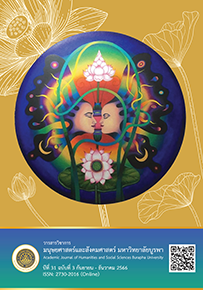Guidelines for the Promotion and Co-regulation of Media Operation and Presentation on Sensitive Issues related to Gender Diversity
Main Article Content
Abstract
The purpose of this study was to explore the support guidelines for regulating media operations and reporting on sensitive LGBTIQ+ issues in Thailand. This research was qualitatively conducted using in-depth and focus-group interviews. Forty-five research participants included television industries experts, LGBTIQ+ key informants, lawyers, journalists, television program producers, psychologists, and LGBTIQ+-content audience representatives. Fifteen participants for in-depth interviews were recruited through a purposive sampling method, and thirty participants for focus-group interviews were recruited using a snowball sampling method. The research tools were semi-structured interview and focus-group interview questions. The data were analyzed inductively.
The study revealed two main findings. First, in reporting LGBTIQ+ content, knowledge and understanding of gender should be earlier addressed, and LGBTIQ+ issues should be presented normally and appropriately for social contexts through appropriate, bias-free style so that audiences perceive LGBTIQ+ content positively as role models with capacity, rather than LGBTIQ+ with negative image. Also, content and language used for LGBTIQ+ should create empathy. Media entrepreneurs should consider their roles and ethics, reporting the content creatively rather than taking advantage of LGBTIQ+ content.
Second, the regulatory guidelines for LGBTIQ+ content should apply the same rules used in general content, where human rights, equality, respect, support, not suppression, should be recognized. Media with self-regulation and regulatory guidelines should be provided for the same standard of practices.
Downloads
Article Details

This work is licensed under a Creative Commons Attribution-NonCommercial-NoDerivatives 4.0 International License.
บทความทุกบทความเป็นลิขสิทธิ์ของวารสารวิชาการมนุษยศาสตร์และสังคมศาสตร์ มหาวิทยาลัยบูรพาเท่านั้น
References
กังวาฬ ฟองแก้ว, อโนพร เครือแตง, สุมน อ่นสาธิต, เมธาวี คัมภีรทัศน์, นิศารัตน์ จงวิศาล, อรอนงค์ อรุณเอก, และ Byrne, J. (2560). สื่อเพื่อการเปลี่ยนแปลง: การทำงานร่วมกันกับสื่อในประเด็นเพศวิถี อัตลักษณ์ทางเพศ สถานะ การแสดงออกและลักษณะทางเพศในประเทศไทย. คณะมนุษยศาสตร์และสังคมศาสตร์ มหาวิทยาลัยบูรพา. https://www.undp.org/sites/g/files/zskgke326/files/migration/th/UNDP_Thailand_TH-tool-for-change-thai.pdf
กัญจิรา วิจิตรวัชรารักษ์, พระมหาอรุณ ปญฺญารุโณ, และสุพัตรา สันติรุ่งโรจน์. (2562). ขบวนการเคลื่อนไหวทางสังคมของกลุ่มผู้ที่มีความหลากหลายทางเพศในประเทศไทย. วารสารมหาจุฬานาครทรรศน์, 6(8), 3758-3772.
กาญจนา แก้วเทพ. (2549). ศาสตร์แห่งสื่อและวัฒนธรรมศึกษา. เอดิสันเพรสโปรดักส์.
จเร สิงหโกวินท์. (2013). สื่อตีตรา: การผลิตซ้ำมายาคติเกย์ในสังคมไทย. วารสารนิด้าภาษาและการสื่อสาร, 18(20), 64-76.
ชีรา ทองกระจาย. (2561). ความเท่าเทียมกันทางเพศสภาพ. ใน เอกสารการสอนประจำชุดวิชา 82427 (หน่วยที่ 5) การพัฒนามนุษย์ในบริบทโลก (หน้า 1-45). สำนักพิมพ์มหาวิทยาลัยสุโขทัยธรรมาธิราช.
นฤพนธ์ ด้วงวิเศษ. (2560). แนวคิดทฤษฎีเรื่อง “ความหลากหลายทางเพศ”. ศูนย์มานุษยวิทยาสิรินธร. https://www.sac.or.th/databases/sac_research/article-detail.php?articleID=56
ประกาศสำนักงาน กสทช. เรื่อง แนวทางการจัดระดับความเหมาะสมของรายการโทรทัศน์. (2556, 29 ตุลาคม). ราชกิจจานุเบกษา. เล่ม 130 ตอนพิเศษ 147 ง. หน้า 1-3. https://broadcast.nbtc.go.th
พนา ทองมีอาคม. (2561). แนวคิดเกี่ยวกับนโยบายและการกำกับดูแลกิจการสื่อสาร. ใน ประมวลสาระชุดวิชา 16720 (หน่วยที่ 1) นโยบายการสื่อสารและการกำกับดูแล (หน้า 1-66). สำนักพิมพ์มหาวิทยาลัยสุโขทัยธรรมาธิราช.
สถานทูตสหรัฐและสถานกงสุลในประเทศไทย. (ม.ป.ป.). รายงานด้านสิทธิมนุษยชนประจำปี พ.ศ. 2563 - ประเทศไทย. https://th.usembassy.gov/th/our-relationship-th/official-reports-th/2020-human-rights-reports-thailand-th/
Capuzza, J. C., & Spencer, L. G. (2017). Regressing, progressing, or transgressing on the small screen? Transgender characters on U.S. scripted television series. Communication Quarterly, 65(2), 214-230. https://doi.org/10.1080/01463373.2016.1221438
Lovelock, M. W. (2016). Interrogating the politics of LGBT celebrity in British reality television [Doctoral thesis, University of East Anglia]. https://ueaeprints.uea.ac.uk/id/eprint/63063/
Leuven, K. U. (2009). Independent study on indicators for media pluralism in the member states towards a risk-based approach: Prepared for the European commission directorate-general information society and media SMART 007A 2007-0002. https://ec.europa.eu/information_society/media_taskforce/doc/pluralism/pfr_report.pdf
McCombs, M. E., & Shaw, D. L. (1972). The agenda-setting function of mass media. Public Opinion Quarterly, 36(2), 176-187.
Pew Research Center. (2015). U.S. public becoming less religious. [Report]. https://www. -pewresearch.org/religion/2015/11/03/u-s-public-becoming-less-religious/
The standard. (2563). SOGIESC หลักการเข้าใจเพศกำเนิด เพศสภาพ และเพศที่อยากให้คนอื่นรับรู้. https://thestandard.co/podcast/ruok195/
Tu, J.-W., & Lee, T.-T. (2014). The effects of media usage and interpersonal contacts on the stereotyping of lesbians and gay men in China. Journal of Homosexuality, 61(7), 980-1002.
Xie, Y., & Peng, M. (2018). Attitudes toward homosexuality in China: Exploring the effects of religion, modernizing factors, and traditional culture. Journal of Homosexuality, 65(13), 1758-1787.


